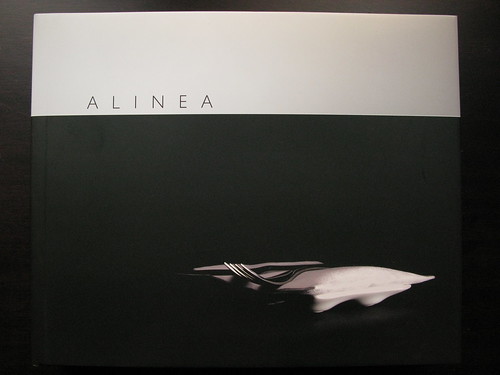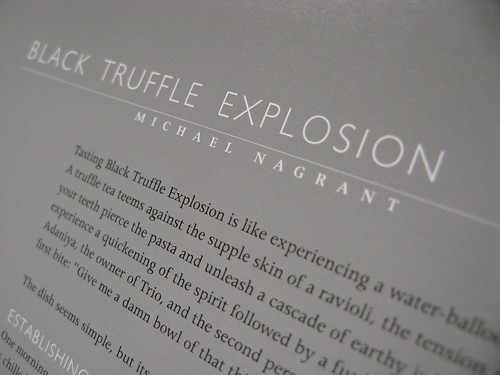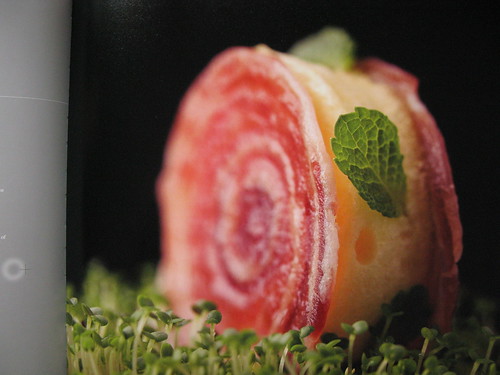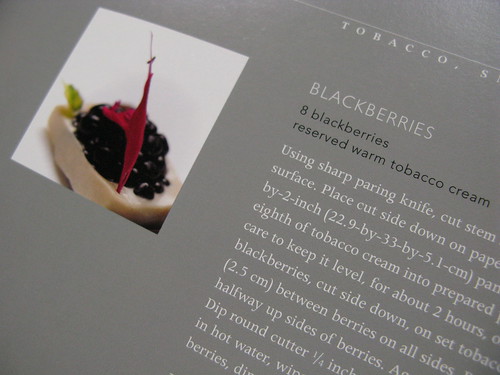| « Autumn with VeganYumYum's Squash | Cabinet Maker Opens the Doors for Healthy School Lunches » |
Feature Fri Oct 24 2008
Behind Alinea, the Book: an Interview with Michael Nagrant
Earlier this month, Alinea, a cookbook collecting more than 100 recipes from Chef Grant Achatz's phenomenal restaurant, made its debut. Weighing in at 6 pounds and more than 400 pages, the hardcover book features essays by Achatz, his partner Nick Kokonas, and food writers Michael Ruhlman, Jeffrey Steingarten, Mark McClusky and Michael Nagrant. It is illustrated with more than 600 photographs of the food and the kitchen by photographer Lara Kastner -- some of the most luscious foodporn you'll see in a long time.
I had the opportunity to interview Michael Nagrant about the book, how he got involved and what it was like writing about one of the country's top restaurants.
You're the least known of the food writers involved in the book. How did they pick you?
Basically, I slipped Nick Kokonas, Alinea managing partner, and Grant Achatz a potent drug cocktail, bound them, and fed them a steady diet of McDonald's until they conceded to allow me in. Seriously, you'd probably have to ask them, but I'm very grateful for the opportunity. What I will say, is that there's the story about how Grant Achatz sent a letter every day for a month to get himself in the door at the French Laundry. I wrote a similar email to Nick and Grant and threatened to do like Achatz. I also wrote a pretty lengthy proposal and marketing plan, maybe longer than all of the writing I did for the book, as to what I would do if given the opportunity to work on this project. I naively believed that proposing scratch and sniff pages and laser holography photography would endear me to them. Indeed it did. Though, truly the lesson is, opportunities don't come to you, you have to go to them. I would have given my a tastebud or two to work on this one, and I made that clear. I think they picked up on that.
How did the writing process work?
In telling any story, I like to find what's seems superhuman or almost mythological yet true about the people or idea being profiled and then temper that with the utter and basic humanity of those subjects, so people can both be awed and yet relate to the story. Given the opportunity to watch the dedication of Chef Achatz, GM Joe Catterson, all of the sous chefs like Greg Baxtrom, Jeff Pikus, designer Martin Kastner, photographer Lara Kastner, and even stages who were just in to observe for a day, tweezing pieces of Thai chili like their life depended on it, it was easy to find the superhuman. All I had to do was sit back watch and listen. The key moments came in silences on phonecalls or during lively debates with Achatz on G-Mail chat, or just tucking myself away in the corner of the kitchen. I pretty much found the humanity the same way.
How often were you in the kitchen?
I didn't spend a ton of time in the kitchen, maybe a couple days. I spent quite a deal more time just sitting down with folks and talking.
Did you eat at Alinea as preparation for the book? How many times?
I did not. In fact the only full meal I've ever had at Alinea, ironically came before I was a food writer three years ago, when I was very poor. I'd just quit my corporate e-commerce job, had no idea I'd become a food writer, but it was my seventh wedding anniversary and as a passionate eater, I knew for whatever reason, it was very important to eat at Alinea, even though we couldn't afford it. Indeed, I still remember thinking how I really wished I could eat there every night, because you knew the menu was changing daily. In fact, I don't really recognize the menu being served today, even though I'd only been in the kitchen a few months ago. It changes that fast. On the other hand, Achatz and his team were very generous when I was in the kitchen, and they plied me with a healthy dose of black truffle explosion, liquid caramel popcorn (the eating of which inspires very Proustian memories of eating fresh caramel corn at Garretts of Michigan Avenue on a cold winter night), and other tasty treats. I still remember Greg Baxtrom, one of the sous chefs, hooked me up with this piece of Guava cloud dusted with lime zest. It's a very simple preparation of juice aerated in a blender with gelatin, but it redefined how I wanted to eat guava. I never really want to drink it or bite it again as much as I want that airy pillow of guava.
What's your favorite dish at Alinea?
I know it seems coy to say it, but truly the next one invented. Progress is the reason for and of Alinea. Though I might say that one dish in particular is very pivotal me, and that was the night I ate there on my anniversary. It's a trout roe dish with pineapple foam square, coriander cream and cucumber gel. I'm paraphrasing, actually exactly phrasing myself from something I wrote a few months ago, but the dish was so great, because instead of serving the usual boric acid adulterated Beluga or Osetra caviar which has been sitting in a tin for who knows how long, the trout eggs in this preparation, pure briny glistening orange orbs, were five days removed from the fish, cured only in sea salt and water by a artisan named Steve Stallard.
In this dish I recognized that while Achatz was truly an original, he also believed in the lessons of the past. For me, the combo of sweet, savory, creamy and salty conjured very closely Thomas Keller's Oysters and Pearls, a dish from Achatz's French Laundry sous-chef days. The importance of pure flavor and finesse was also articulated in a single coriander seed, the most intensely spicy and floral coriander I ever had. This was as close to the land as it got, the discrimination to find a seed and roe of such quality meant that the farmer and the fisherman were just as, if not more important, in the cuisine at Alinea as they were at local/sustainable, "farm to table" style restaurants.
What was it like working with Grant, Nick and the other chefs? Who did you have the most interaction with?
You know, I spent most of my time on the phone, in the kitchen, in the dining room and on Gmail chat with Achatz. I think I said it earlier though, what's remarkable about watching this crew is that most people have a hard time getting their whole family together for Thanksgiving dinner. At Alinea, you really believe some of the folks would cut off a finger if it improved the experience. I'm sure there's all kinds of motivations for people, whether it's furthering their career, putting up a resume bullet, a starstruck love for Achatz, etc, etc... but that stuff still only takes you so far... there really is this intense drive within most of the folks to operate as if they were Achatz or Kokonas, i.e. one of the major stakeholders. Ultimately, like anything, you have to know what's most important to you and then continue to commit to that in the most challenging or mundane moments. That's what every day is like with the Alinea team.
Your essay is on the Black Truffle Explosion, Grant's most famous dish. What was the research like for the piece? How many times (if at all) did you get to sample the dish?
It's the perfect microcosm for the restaurant. You think, oh it's food, but in reality as outlined in the essay, the dish broke some chefs, made some chefs, and formed an informal brotherhood of those who had to make it for a long period of time. It was a dish that inspired sous chef Jeff Pikus to come work for Achatz at Trio. It was a labor of love and refinement. They didn't put it out and just say, hey we're done with it. They found 10 different ways to refine it to make it better. Even today, it's never really done. It gets served with white truffles, or caramelized romaine or some alternative garnish. I got to taste it quite a few times, but as with anything great, always once less than I require.
I understand you wrote quite a few essays for the book, but only the one made it into the final version. What happened? Will those other pieces ever see the light of day?
You know how rock stars have clauses in their contracts about removing all the brown M&M's? I believe Jeffrey Steingarten and Michael Ruhlman had clauses that dictated page count for Mark McClusky and I such that they wouldn't be overshadowed. That and Ruhlman requested a year's supply of hair gel for his Flock of Seagulls-like hairdo. Seriously, there was just a space constraint with printing deadlines. The other pieces are slated to appear on the Alinea mosaic website in the next month or so. I'm especially excited about the pieces on Hot Potato, Cold Potato, wine service, and another about sous chef Greg Baxtrom that shows how even Alinea isn't totally pefect. I especially enjoyed doing the wine service piece, because I honestly believe that Joe Catterson's work at Alinea has created the best wine pairing program in the world. You can debate all day long about whether El Bulli, Fat Duck, French Laundry, Alinea or Charlie Trotter is the best restaurant in the world... I don't believe anyone is pairing wine like Catterson and Craig Sindelar. There's too much emphasis on first growth Bourdeaux and trophy wines and full bottles every where else. The singular glass pairings at Alinea are one of a kind. Some choices come from Slovenia for god sakes. Catterson sometimes opens up 30 or 40 bottles with a dish change to find the right pairing. It's impossible to not to be hyperbolic when I think about it. Everyone inherently understands a chocolate chip cookie with a glass of milk or even a red wine with a piece of meat, but what happens when you mix homemade lobster cheetos with lemongrass broth... then what grape do you pull out? They find a way.
This is a cookbook that very few people will likely ever actually cook from. Knowing this, did you approach the project differently?
It may be true that people perceive the book as very difficult and therefore are intimidated by it. On the other hand I believe many of the recipes are very accessible. Black Truffle explosion or Hot Potato are very accessible for the home cook. The hardest part might be procuring the black truffle, which with the internet or say Fox and Obel here in Chicago isn't really that hard to do. There are a lot of steps, it's true, but like most things worth doing, you have to be dedicated. It might be a little harder to find, say, isomalt, or some more exotic ingredients for other recipes, but then again, the internet is a wonderful thing.
When the French Laundry cookbook came out years ago, I think people said the same thing. I mean seriously, who was making short ribs by marinating the raw meat, braising the ribs, then straining the sauce five times and then roasting a second set of fresh vegetables for the finished dish? That's almost the standard for good restaurants these days. And I think frankly a lot of home cooks even buy that... I know I do.
Ruhlman wrote an essay on his blog recently that I really agreed with, which is to say, the fallacy of the cookbook industry is that cooking is super-easy, that anyone can do it, or that they can figure out Robuchon or Ducasse in five easy pieces or through 10 30-minute meals. If you could be Ducasse in a week, why are so many people frittering away their children's college fund eating at his restaurants? To be Grant Achatz is to have worked at the French Laundry for years, to have staged at the best restaurants in the world, to have gone to the best culinary school in America (CIA Hyde Park), to have worked as winemaking apprentice, to have hunkered down over a notepad until 3am working out ideas on your days off every day for a decade, sometimes while you're going through chemotherapy and radiation treatment. It's not easy.
That being said, if you're a young line cook with ambition or a serious home cook, do you want shortcuts, or do you want the true depiction of what it took Achatz 10 or 15 years to learn? I know what I'd want. That's not to say it's for everyone, but if you only want good basic ravioli that's what Mario Batali, Jamie Oliver, or Lidia Bastianich are for. If you want to make black truffle explosion, that's what this book is for.
Have you tried making any of the recipes? How did it turn out?
I've re-created the guava foam I spoke of above, and it worked really well. Likewise, I've made a riff on Hot Potato, Cold Potato that turned out well. I hope to do some more this winter as time permits. I'd say Nick Kokonas' essay in the book on how to make the recipes your own is really worth a look. You don't need a Pacojet or Volcano infuser to achieve the same effect. Likewise, the lesson about cooking that's as old as Julia Child is that recipes are just a starting point, a blueprint that you adopt and modify. Not having truffles doesn't mean you can't make a kick ass stock with really good porcini mushrooms.












